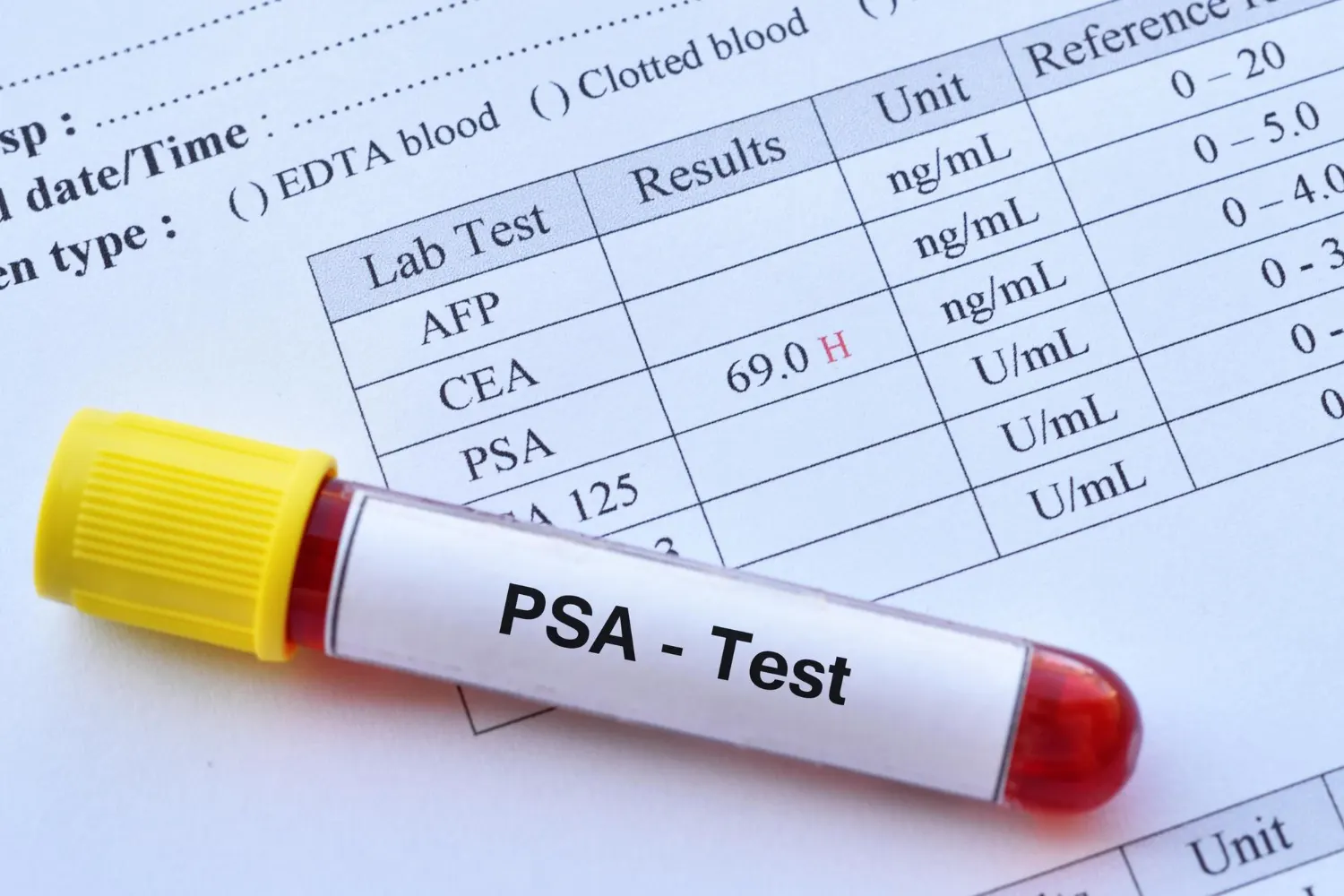Prostate cancer remains one of the most prevalent cancers affecting men worldwide, with an estimated 1 in 8 men diagnosed during their lifetime. While prostate cancer is often slow-growing, early detection plays a vital role in improving treatment outcomes and reducing mortality. The Prostate-Specific Antigen (PSA) test has long been a key screening tool for identifying prostate issues, yet misconceptions about its accuracy, reliability, and necessity persist.
For men navigating decisions about prostate health, understanding the PSA test’s purpose, benefits, and limitations is crucial. This comprehensive guide answers common questions about PSA screening, providing men with the knowledge they need to make informed healthcare choices.
In This Article
What Is a PSA Test and Why Is It Important?
The PSA test measures the concentration of Prostate-Specific Antigen (PSA) in the blood. PSA is a protein produced by the prostate gland, and while small amounts are normal, elevated PSA levels may indicate prostate conditions such as:
- Prostate Cancer
- Benign Prostatic Hyperplasia (BPH) (non-cancerous prostate enlargement)
- Prostatitis (inflammation of the prostate)
- Urinary Tract Infections (UTIs)
Since elevated PSA levels do not always indicate cancer, this test is used in combination with other diagnostic tools to assess prostate health.
Why Is PSA Screening Important?
PSA screening offers significant advantages in detecting prostate cancer early, particularly in men who are at higher risk. Key benefits include:
1. Early Cancer Detection
PSA screening can identify prostate cancer in its earliest stages — often before symptoms develop — when treatment is most effective. Early detection dramatically improves survival rates, particularly for aggressive cancers that would otherwise spread rapidly.
2. Improved Treatment Outcomes
When prostate cancer is identified early, treatment options are often less invasive and more effective. This can reduce the need for aggressive therapies that carry greater risks of side effects.
3. Monitoring Prostate Health
PSA testing can help doctors track prostate health over time, revealing changes that may require further investigation. By observing PSA trends rather than relying on a single result, healthcare providers can better assess a patient’s risk profile.
4. Risk Reduction in High-Risk Populations
Studies have shown that PSA screening reduces prostate cancer mortality in high-risk groups, including Black men and those with a strong family history of prostate cancer. For these groups, earlier and more frequent screening can be life-saving.
Who Should Get a PSA Test?
The decision to undergo PSA screening depends on a combination of age, family history, and individual risk factors.
Recommended Screening Guidelines
| Risk Group | Recommended Screening Age | Screening Frequency |
|---|---|---|
| Average risk | Age 50+ | Every 2–4 years if PSA is within normal range |
| High risk (family history, Black men) | Age 40–45 | Annually or as advised by a doctor |
| History of elevated PSA | Any age | As recommended by a healthcare provider |
Key Risk Factors
- Age: Risk increases significantly after age 50.
- Family History: Men with a first-degree relative diagnosed with prostate cancer have double the risk.
- Ethnicity: Black men are more likely to develop aggressive prostate cancer at a younger age.
- Lifestyle Factors: Obesity, smoking, and poor diet may increase risk.
What Are Normal PSA Levels?
There is no universal “normal” PSA threshold, but the following table outlines general guidelines:
| Age Group | Normal PSA Range |
|---|---|
| 40–49 years | 0.0 – 2.5 ng/mL |
| 50–59 years | 0.0 – 3.5 ng/mL |
| 60–69 years | 0.0 – 4.5 ng/mL |
| 70+ years | 0.0 – 6.5 ng/mL |
What Can Cause Elevated PSA Levels?
Aside from cancer, other conditions and activities can elevate PSA levels:
- Enlarged Prostate (BPH)
- Prostatitis (prostate inflammation)
- Urinary tract infections (UTIs)
- Recent ejaculation
- Vigorous exercise, especially cycling
What Happens If My PSA Levels Are Elevated?
Elevated PSA levels do not always indicate cancer. Additional tests can help clarify the situation.
Follow-up Steps After an Elevated PSA Test
- Repeat PSA Test: Since temporary PSA fluctuations can occur, a repeat test may confirm if the elevation persists.
- Digital Rectal Exam (DRE): A physician may manually check the prostate for abnormalities.
- Imaging Tests: MRI or ultrasound may provide additional insights.
- Biopsy: If concerns remain, a biopsy may be required to confirm or rule out cancer.
What Are the Benefits of PSA Screening?
PSA screening has shown measurable success in reducing prostate cancer deaths when combined with thoughtful follow-up care.
Key Benefits
- Reduced Mortality: Studies show PSA screening prevents 1 death for every 11–14 men diagnosed with prostate cancer.
- Early Detection of Aggressive Cancers: PSA screening is particularly effective at identifying fast-growing cancers that may otherwise go unnoticed.
- Informed Treatment Decisions: For men diagnosed with prostate cancer, PSA levels help guide treatment options, balancing aggressiveness with the risk of overtreatment.
What Are the Risks of PSA Screening?
Despite its benefits, PSA screening is not without limitations.
False Positives
Elevated PSA levels may result from non-cancerous conditions, causing anxiety and leading to unnecessary biopsies.
Overdiagnosis and Overtreatment
PSA screening often detects slow-growing cancers that may never pose a serious health risk. As a result, some men undergo invasive treatments that could have been avoided.
Biopsy Risks
Biopsies carry potential risks such as infection, bleeding, and discomfort. Healthcare providers now increasingly rely on MRI-targeted biopsies to reduce these risks and improve diagnostic accuracy.
How Can I Prepare for a PSA Test?
Proper preparation helps ensure your PSA test results are as accurate as possible.
Before the Test
- Avoid Ejaculation: Refrain from ejaculation for 48 hours before the test to prevent temporary PSA elevation.
- Limit Strenuous Exercise: Activities like cycling may increase PSA levels and should be avoided for 48 hours.
- Discuss Medications: Drugs such as finasteride or dutasteride may artificially lower PSA levels. Inform your doctor about any medications you’re taking.
Day of the Test
- Drink water before the test to stay hydrated.
- Inform your healthcare provider if you have experienced any recent infections or urinary symptoms.
What Are My Options After a PSA Test?
PSA results typically fall into one of these categories:
| PSA Result | Recommended Action |
|---|---|
| Normal Range | Continue routine screening |
| Slightly Elevated | Repeat PSA test in 3-6 months |
| Moderately Elevated | Consider additional testing (DRE, MRI) |
| Significantly Elevated | Referral for biopsy evaluation |
Should I Be Concerned About PSA Test Accuracy?
While the PSA test is valuable, it’s not perfect.
Accuracy Statistics
- Sensitivity: Detects cancer in 85% of cases.
- Specificity: Can incorrectly suggest cancer in 15-20% of cases.
Newer tests such as the Prostate Health Index (PHI) and 4Kscore® offer improved accuracy by identifying aggressive cancers more reliably.
Conclusion
The PSA test remains a powerful tool in the early detection of prostate cancer. While not without limitations, PSA screening can reduce mortality rates and improve outcomes when combined with informed decision-making.
Men are encouraged to discuss PSA screening with their healthcare provider, especially if they are over 50, have a family history of prostate cancer, or belong to a high-risk demographic. By understanding the test’s benefits and limitations, men can take proactive steps in safeguarding their long-term health.
References
- National Cancer Institute. (2024). Prostate-Specific Antigen (PSA) Test.
- University Hospitals. (2023). New Research Shows Benefits of PSA Screening.
- Prostate Cancer UK. (2024). PSA Blood Test.










0 Comments